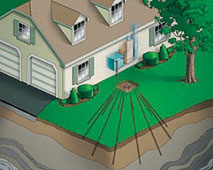New Home Heating & Cooling System is Easier on the Wallet - and the Environment
 General industry and consumers will benefit from lower energy bills with the development of premium-efficiency electric motors that rely on all-copper rotors.
General industry and consumers will benefit from lower energy bills with the development of premium-efficiency electric motors that rely on all-copper rotors.Illustration courtesy of ECR Technologies.
High-resolution version of this photo.
As fuel prices continue to rise, many homeowners are looking for new, more energy-efficient means of heating and cooling their homes. One system praised for being both highly efficient and environmentally friendly is geothermal heat pump (GHP) technology.
Unlike conventional heating systems, geothermal, also known as ground-source or Geoexchange systems, don't burn fossil fuels to produce heat. Instead, they use the supply of natural thermal energy located just below the earth's surface.
Compared to the air outside, which varies from hot to cold depending on the season, the temperature just a few feet underground remains at a relatively constant 50 to 60 degrees Fahrenheit year-round.
Many animals take advantage of this warmth by burrowing holes in the ground where they hibernate away from winter's cold. Similarly, geothermal heating systems employ buried pipes to access the earth's warmth for indoor heating.
Direct and efficient
There are several types of geothermal systems, but the most efficient is a technology called directexchange (DX) geothermal, which uses copper piping to harvest the earth's energy.
Here's how geothermal DX works:
- In the winter, a refrigerant is circulated through a closed-loop system made from copper tubing. Copper, an excellent heat conductor, transfers the warmth from the earth to the refrigerant.
- As the refrigerant is heated, it becomes a vapor and is sent to a compressor located inside the home.
The compressor, which makes about as little noise as a refrigerator, raises the vapor's temperature to 130-160 degrees, then sends it to a copper coil located inside the home's air handler system. - The air handler blows cool air over the hot coils (similar to the way air circulates through a typical oil- or gas-fired furnace) then distributes the heated air through the home's ductwork.
In the summer, the system is reversed:
- The air handler takes hot air from inside the home and blows it over indoor coils filled with refrigerant.
- The cooled air is then distributed throughout the house, while the refrigerant (now a vapor) is sent through the underground copper loop, where its heat is transferred to the earth.
For additional energy savings, DX systems are frequently designed with another heat exchanger connected to the hot water system that produces hot water using heat from the ground.
Geothermal DX is not only more energy- efficient than systems that burn fuel for energy, it also supplies more consistent heating, according to Don Creyts, president of Advanced Geothermal Technology, which has been installing geothermal DX systems since 1989.
While forced air furnaces are notorious for producing short blasts of intense heat that rob moisture from the air - leading to dry skin and other ailments - geothermal DX systems have longer operating cycles that produce a steady stream of 100-degree heat. This is only slightly higher than the body's own temperature, so it isn't as drying, says Creyts.
So, when system comfort is compared, DX geothermal wins again.
DX geothermal also outperforms waterbased GHPs, which utilize plastic, not copper pipes underground. Plastics can't transfer heat as effectively as copper, says Creyts, nor can they carry refrigerant. Instead of refrigerant, a solution of water and antifreeze is circulated through the pipes. The liquid absorbs some of the adjacent ground heat, but must be pumped aboveground before it can transfer its heat to a refrigerant. This extra heat exchange, says Creyts, uses more energy, making plastic pipe systems less efficient than copper.
In comparison, the only energy costs associated with DX systems is the electricity needed to run the compressor unit and the fan inside the air handler, Creyts says.
Energy experts say that homeowners who purchase a DX geothermal system can recoup their initial investment in 3 to 5 years, depending on the local cost of electricity. However, many states and municipalities offer tax incentives, which can greatly speed the rate of return.
According to ECR Technologies, which began marketing DX geothermal systems in 1992, homeowners can easily retrofit their homes with a DX system by making minor modifications to their current air handler system and installing the copper earth loops and the compressor unit. Cu
Resources:
Advanced Geothermal Technology
ECR Technologies
National Building Museum
Also in this Issue:
- A Fixture in American Homes
- New Home Heating & Cooling System is Easier on the Wallet - and the Environment
- Egyptian Pharaoh Had Copper Plumbing
